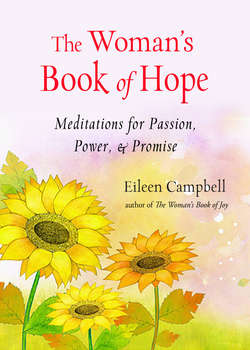Читать книгу The Woman's Book of Hope - Eileen Campbell - Страница 12
На сайте Литреса книга снята с продажи.
6. Finding meaning and purpose
ОглавлениеHumans have a fundamental need to feel that life is worthwhile and that what we do makes a difference. We may be rich, successful, even famous, but that's not enough—we have to have a reason to live. It may well be easier for a camel to enter the eye of a needle than for a rich man to enter heaven! In the long run, without a meaningful existence, life is empty and unfulfilling.
To make sense of our existence, we need to see ourselves as part of something greater—a family, a community, a society. We need to seek a cause beyond ourselves, and it has to be worth making sacrifices for. Many find meaning through loving and caring for others or trying to have a beneficial impact on the lives of others. Ultimately, seeing ourselves as on a spiritual path makes the difference, and every life event—negative or positive—is a clue to our purpose and becoming our best selves. Rudolf Steiner, the founder of Anthroposophy and the Waldorf Schools, wrote:
If we do not develop within ourselves this deeply rooted feeling that there is something higher than ourselves, we shall never find the strength to evolve to something higher.
There are many examples of those who have come to this realization in a variety of ways—from saint to sinner.
Mother Teresa, the founder of the Order of the Missionaries of Charity, was canonized as St. Teresa of Calcutta in 2016. In spite of intense inner struggles on her spiritual journey for much of her life, Mother Teresa found meaning and purpose through her work with the poor, the sick, and the dying. She was unwavering in her dedication to helping and giving hope to those in need. “Love cannot remain by itself—it has no meaning,” she wrote. “Love has to be put into action, and that action is service.”
A very different story of hope is that of Moyo (a Swahili name meaning heart or spirit), who has been held on death row for the past sixteen years, having committed two murders when he was eighteen. He does not expect to be let out of solitary confinement, but his hope is to spend his time in worthwhile ways. In trying to understand himself and what happened, he has become an avid reader. He has committed himself to a regular practice of yoga and meditation. He says, “In this cell I have learned the art of patience, the art of silence, and its fruits are sweet. I have learned the art of introspection and what it can do to improve one's sense of self.”
Moyo also communicates with the world outside through letters and met Maria Jain through a prison pen-pals initiative. The same age, but with very different lives, they began to meditate together sitting in their different time zones. Out of the deep friendship that developed came the exhibition titled “Buddhas on Death Row.” When meditating in his cell one day, Moyo decided that he would like to study the image of the Buddha through a series of portraits. Maria helped organize an exhibition of his work at an art gallery in Helsinki. The portraits are accompanied by reflections on suffering and happiness, conflict and peace, impermanence and eternity, ignorance and awareness.
Moyo continues to be committed to the work of transformation. Instead of feeling anger and resentment, as he once did, he sees himself as working to “polish his soul, clean stains from his heart, and open windows of his mind.” He has chosen to find meaning and purpose in his situation.
However dire the circumstances, there is always hope, as Moyo's story shows, not necessarily that the situation will end, but that the situation looks different. As human beings, we clearly have the capacity for transformation, even in the darkness, when we find a meaning and purpose to our existence.
I know that however difficult my situation is, hope is always available.
I am learning to make sense of my existence.
I spend my time in worthwhile ways.
